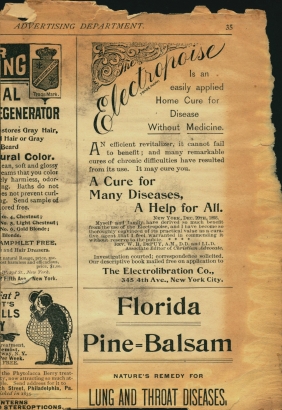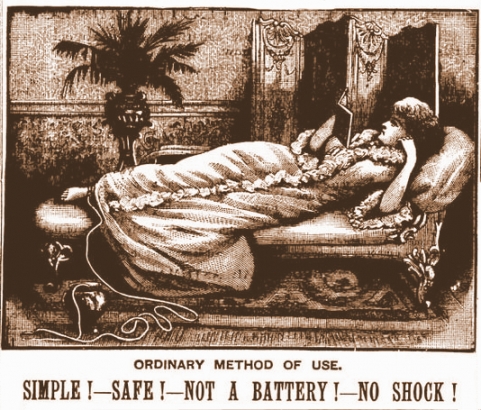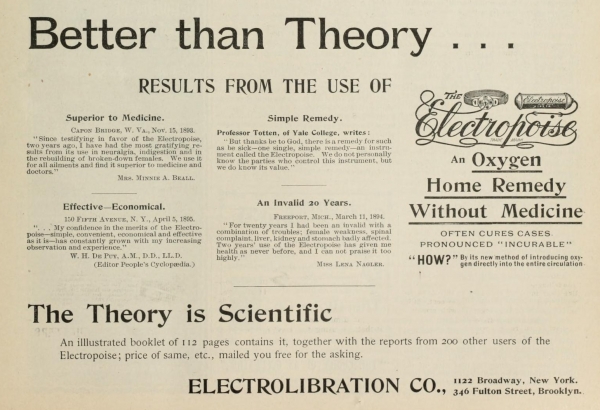A while back, one of my amazing coworkers here in the Western History and Genealogy Department stumbled across an old scrap of newspaper tucked away in a book. The discolored page was dominated on one side with an ad for the Electropoise (shown below), and thinking that this was something right up my alley, she diligently passed it on to me. I did a little digging, starting with Nostrums and Quackery (my go-to source on medical absurdities), and as it turns out, she was spot on.
The Electropoise was invented by Dr. Hercules Sanche, a man who claimed to have “discovered” the Laws of Spontaneous Cure of Disease. You read that right; he actually claimed to have been the first person to notice that when someone gets sick, they sometimes get better on their own. Where you and I might write this off to the wonders of the immune system, Sanche saw it as an untapped revenue stream.
Pills, tonics and unguents were, of course, highly popular (and lucrative) means of providing “treatments” to the unwary public, but Sanche went a slightly different route. Newfangled electricity was driving many fads in that era, and Dr. Sanche opted to capitalize on that trend, at least when it came to naming his product.
Despite its name, and the product’s appearance (which certainly resembles a rudimentary electrical apparatus), the Electropoise neither generated electricity nor required it to function. (I’m using the word “function” extremely loosely, as you’ll see.) In fact, the instructions included with the device even cautioned the patient, “Do not expect any sensations of current or shock. Nature does not work that way.”
The instrument was comprised of two parts connected by a length of cord: a sealed nickel-plated brass cylinder dubbed the polizer, filled with “a composition, the nature of which is not made known to the public,” and an elastic strap with a buckle and a small metal disk attached. The elastic band would be placed around the wrist or ankle with the metal disk flush against the skin. The polizer, meanwhile, would be placed in a bucket (or other suitable container) of cold water or ice. Then, through the mysteries of “Diaduction” (a force Dr. Hercules claimed to have discovered, and which he insisted on capitalizing), the device would draw healing oxygen (the vitalizer of the blood) from the water and force it into the user’s system. The claim held that this resulted in “burning out all manner of poisonous impurities” among other things, and would therefore cure everything from indigestion to tuberculosis, as well as “nervous prostration” and other “female weaknesses."
The fact that there was absolutely no scientific evidence for this claim, nor for the existence of “Diaduction” in the first place, didn’t stop the product from selling like hotcakes in a town long deprived of hotcakes. The base model sold for $10 (a little over $250 in today’s market), with more elaborate versions (one of which could be mounted to a wall) selling for as much as $50. When some in the medical community, skeptical of Sanche’s outlandish claims, dissected a polizer, they discovered (to no one’s amazement) that it was, in fact, merely an empty tube, which goes a long way to explaining why the contents weren’t made known to the public. Despite this revelation, the product continued to sell.
So began the era of what came to be known as the “gas pipe fraud,” but the saga is far from over. Be sure to check back soon to see how the story ends! In the meantime, why not like our Facebook page so you don’t miss out on any of our other intriguing glimpses into the past?
Special thanks to newly-minted librarian Becky Geller for bringing this bit of frippery to my attention!




Comments
There's sure to be more where
There's sure to be more where that came from! I'll take a wall-mounted model, please. Perhaps the special substance inside the tube WAS magical oxygen - you just can't patent magic. (Actually, you probably can protect a magic trick under trade secrets, but that's a whole 'nother story.)
Thanks for the mention!
Believe me, there's more. I'm
Believe me, there's more. I'm sure if Sanche had thought of Magical Oxygen, he would have tried to patent it.
Thank YOU for pointing me toward what turned out to be a very entertaining tale!
These days, Dr. Sanche would
These days, Dr. Sanche would be known as an osteopath...
I don't know... osteopaths
I don't know... osteopaths have to go to school and get certified and all that. I'm guessing he'd go by Dcotor Hercules (with Doctor in quotes) and run a holistic medicine shop out of the back room of a dry cleaner.
I was digging in my back yard
I was digging in my back yard in Suffern, NY when I found this metal object with the following markings: "Electropoise" "Birmingham, Ala.""PAT'D MARCH 31, ????" "MADE IN U.S.A," "D20597" There are other words but some of them are worn. Nice to find out what it actually was used for. Thank you.
That's very intriguing, Susie
That's very intriguing, Susie! Glad This post could be of some help. I'd be thrilled if you would send me a picture of the device:
croot@denverlibrary.org
I have a newspaper clipping
I have a newspaper clipping from February 1893 about a young lady who took an overdose of morphine. Doctors were called. They did everything possible but is became "apparent she would die". An hour later, "At 11 o'clock a man with an electropoise machine appeared at the house and asked permission to apply it to the young lady. After using it for half an hour, Mrs. H----- seemed much better." Unfortunately, she died at "1:20 o'clock", less than 2 hours later.
Thanks for sharing that, Jan!
Thanks for sharing that, Jan! Sad outcome, but not terribly unexpected. I'd wager there was not much that could be done for a morphine overdose at that time, and since using the Electropoise was tantamount to doing nothing at all, at least it didn't do any harm.
Add new comment